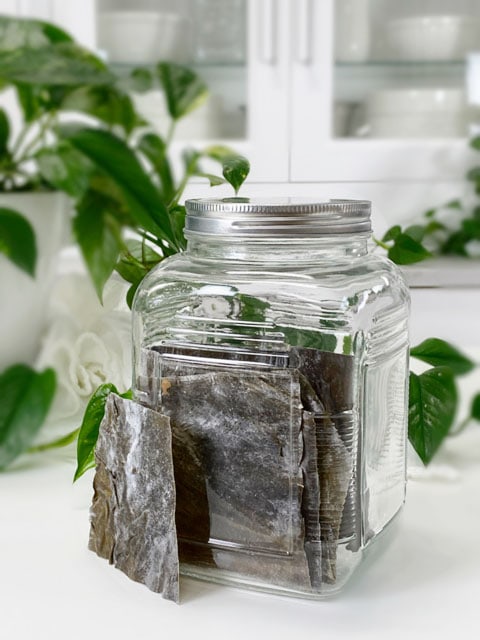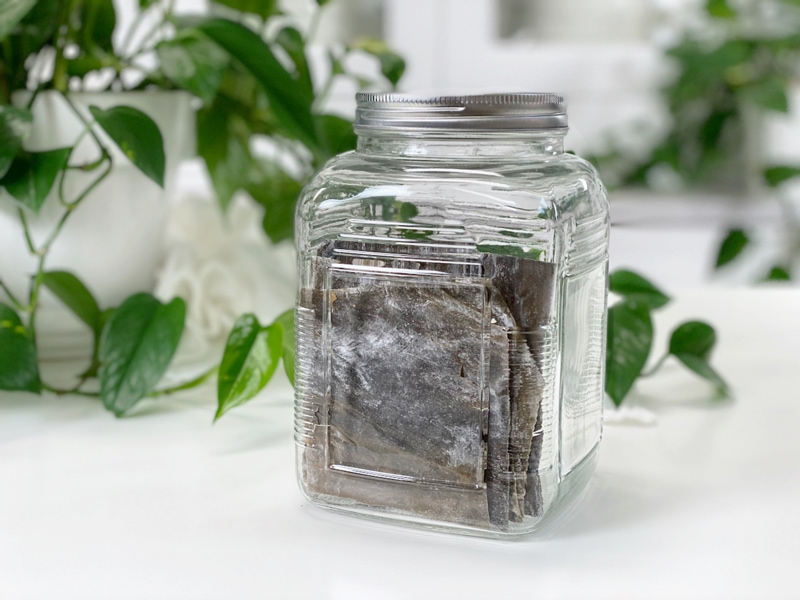


 Add to favorites
Add to favorites
I learned the technique of using kombu seaweed years ago, and it has become a cornerstone of my cooking skills. Before I dive into this, I want to clarify (for those of you who squirm when the word “seaweed” comes up) that kombu seaweed doesn’t affect the taste of the foods you are cooking it in! With that out of the way, you might be more interested in hearing what I have to share today.

Kombu is an edible kelp that is found in sea forests, also known as kelp forests. These forests are very beneficial by providing an important ecosystem for the organisms that live between the seafloor and the surface of the ocean. It is typically dried and sold in sheets, though it can come in a powder. I get mine at our local grocery store in the health food department, but you can find it online as well. Make sure to buy organic.
It is high in vitamins A, C, E, B1, B2, B6, and B12. Seaweed also contains a substance (ergosterol) that converts to vitamin D in the body. In addition to essential nutrients, seaweeds provide us with carotene, chlorophyll, enzymes, and fiber. It is also rich in minerals, including potassium, calcium, and iodine. Kombu has higher iodine content than other seaweed, approximately 95 times that of nori and 4.4 times that of hijiki seaweed. (1)
It has a very mild flavor and won’t affect the taste of the dish. Because it contains natural glutamic acid (the basis of MSG), it is a natural flavor enhancer. It adds umami to dishes, while also providing valuable minerals and nutrients to food it is cooked with. It has a saltiness that comes from a balanced, chelated combination of sodium, potassium, calcium, phosphorus, magnesium, iron, and a myriad of trace minerals found in the ocean. When you open a package you will notice what appears to be a white powder on the kombu–this is normal and doesn’t need to be washed off.
To cook with it, add a 3-4″ strip to the cooking water of beans, rice, rolled oats, steel-cut oats, polenta, millet, quinoa, rice, homemade vegetable broths, and soup recipes. It’s an edible sea vegetable, so once the cooking process has completed, pull out the kombu, chop it into small pieces and place it back into the pot. You can also store it in the fridge and add it to the next pot of food you make.
If you suffer from thyroid problems or are on potassium medication or blood thinners, please take extra caution by consulting your doctor. This goes for any seaweed, actually. I am not a medical expert or nutritionist. I am only here to share what I have learned over the years and the ingredients that I use in my recipes.
Hi, I just found you. I was looking for Kombu, I had made Adzuki bean soup with Kombu some years ago and lost the recipe. Now I’m looking for foods and recipes with Potassium for my Hubby who has low Potassium and gets tired of eating bananas and I get tired of baking banana bread. So I put Adzuki beans and Kombu on our grocery list for tomorrow when we go to Sprouts. Thanks for all the info. :)
Good evening Dianne,
I am so glad that you stumbled upon my site. I hope you enjoy your time while browsing through it. I have over a decade of time poured into it. :) There are so many potassium-rich foods. Here are a few ideas (if you need more variety):
Dried fruits (raisins, apricots)
Beans, lentils
Potatoes
Winter squash (acorn, butternut)
Spinach, broccoli
Beet greens
Avocado
Bananas
Cantaloupe
Oranges, orange juice
Coconut water
Tomatoes
Dairy and plant milks (soy, almond)
Yogurt
Cashews, almonds
Many blessings, amie sue
Hi Diane, I had an all natural doctor in Grapevine, Texas Dr. Constatini I think that’s his name and he recommended that I eat a Adzuki beans cooked with kombu and I also lost the recipe. I haven’t heard of too many using that combo
Very interesting article about kombu.
I have a question I am hoping you will have an answer for.I am cooking black soybeans to use later for making chili. I soaked them all night and have been cooking and simmering them for several hours to try to get them to soften up a bit. Not much success, kind of like a cooked garbanzo bean.
I noticed an ingredient listed on a can of black soybeans I have in my pantry. It lists seaweed as an ingredient and explains on the label that seaweed helps to make the soybeans tender when canning them. Is this a true statement? Would it have made a difference if I had put Kombu in my black soybeans when cooking? If I used a pressure cooker would that have helped get them more tender?
Hello Doreen,
I wish I had an answer for you but I don’t have any experience with cooking soybeans. We don’t eat them so I’ve never dabbled with them. I would use Kombu anyway… I add it to all the legumes and grains I cook. I did read that a pressure canner works great for soybeans, as it does with other beans. I wish you the best. blessings, amie sue
you spoke about cooking a strip of seaweed with the rice or soup and cutting it up afterwards and putting it back in the pot. my husband would never est chopped up seaweed…what do you think about sending it dry thru a food processor before adding to rice so all he may see is a green color instead of chunks. Basically I am trying to “sneak” this powerhouse into our meal plans
Hello Debbie,
I know how it is to sneak healthy foods into meals. :) I think your idea would work perfectly! If you try it, let me know if he notices. hehe blessings, amie sue
Hi!…do you have a plant based cookbook?…awesome recipes!…ty
Hello Arturo, No I don’t have a cookbook, just my online site. :) blessings, amie sue
Hi Amie,
Im so thankful that a friend recommended your website. Now because of your kindness I can enjoy tasty healthy food. Thank you
Welcome Mary, I am so happy that you found my site. I hope you find much inspiration! I am always here for questions or comments. Enjoy and happy holidays! amie sue